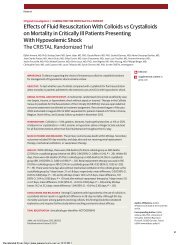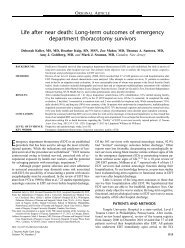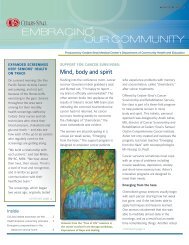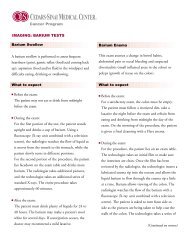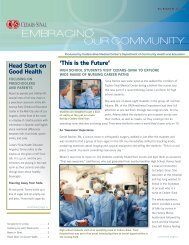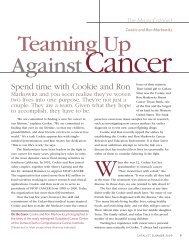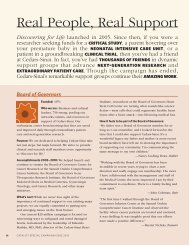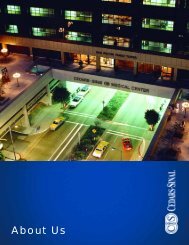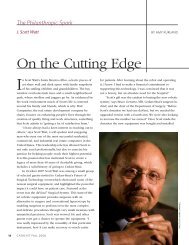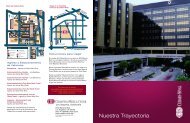the hands - Cedars-Sinai
the hands - Cedars-Sinai
the hands - Cedars-Sinai
Create successful ePaper yourself
Turn your PDF publications into a flip-book with our unique Google optimized e-Paper software.
<strong>the</strong> <strong>hands</strong><br />
of cedars-sinai<br />
our report to <strong>the</strong><br />
community | 2005<br />
LEADING THE QUEST FOR HEALTH
<strong>Cedars</strong>-<strong>Sinai</strong> by <strong>the</strong> Numbers<br />
July 1, 2004–June 30, 2005<br />
Patient Days:<br />
281,976<br />
Outpatient Visits:<br />
301,691<br />
Inpatient Visits:<br />
54,161<br />
Emergency Department Visits:<br />
77,942<br />
Patients Cared for by <strong>Cedars</strong>-<br />
<strong>Sinai</strong> Medical Care Foundation:<br />
130,000<br />
Psychiatry and Mental Health<br />
Inpatient Visits:<br />
18,096<br />
Approximate Total Number<br />
of Research Projects:<br />
600<br />
Total NIH Research Funding:<br />
$27.8 Million<br />
Total Number of Residents<br />
Trained:<br />
336<br />
Donations:<br />
$45.1 million<br />
Total Volunteer Hours:<br />
Approximately 200,000<br />
Community Benefit<br />
Contribution:<br />
$130 million<br />
(Includes free and part-pay care for <strong>the</strong><br />
uninsured and those with limited means, <strong>the</strong><br />
unpaid costs of government programs and<br />
hundreds of community service programs at<br />
<strong>the</strong> Medical Center and in local schools,<br />
homeless shelters and community centers.)<br />
Mr. Law and Mr. Priselac stand in front of a scale model of <strong>the</strong> new Saperstein Critical Care Tower,<br />
a major addition to <strong>the</strong> <strong>Cedars</strong>-<strong>Sinai</strong> campus. The tower significantly expands <strong>Cedars</strong>-<strong>Sinai</strong>’s<br />
ability to meet <strong>the</strong> community’s growing healthcare needs, and consolidates intensive-care units<br />
in a patient-centered environment.
Leadership Message<br />
As a major academic medical center, <strong>the</strong> scope of what occurs on a daily basis at <strong>Cedars</strong>-<strong>Sinai</strong><br />
is hard to capture briefly in words and pictures. With literally thousands of outstanding programs<br />
in patient care, research, teaching and community service, a mere list of programs and accom-<br />
plishments doesn’t really tell <strong>the</strong> whole story of who we are and what distinguishes <strong>Cedars</strong>-<strong>Sinai</strong><br />
Health System, comprising <strong>Cedars</strong>-<strong>Sinai</strong> Medical Center, <strong>the</strong> Burns & Allen Research Institute and<br />
<strong>the</strong> <strong>Cedars</strong>-<strong>Sinai</strong> Medical Care Foundation.<br />
The publication you are now holding is an attempt to move beyond a catalog of achieve-<br />
ments and instead provide a sense of <strong>the</strong> people of <strong>Cedars</strong>-<strong>Sinai</strong>_who <strong>the</strong>y are, what <strong>the</strong>y do,<br />
what drives <strong>the</strong>m, and why <strong>the</strong>y are here_since <strong>the</strong>y are truly <strong>the</strong> core of this institution. They<br />
are <strong>the</strong> differentiating factor, enabling us to continually set new standards in quality and<br />
innovation in patient care, research, teaching and community service.<br />
As you will see in <strong>the</strong> pages ahead, <strong>the</strong> people of <strong>Cedars</strong>-<strong>Sinai</strong> comprise a wide array of<br />
professions and backgrounds: physicians and nurses, technicians, pharmacists, philanthropists,<br />
researchers, educators, mental health clinicians and volunteers, to name just a few. And because of<br />
<strong>the</strong> limited number of pages in this publication, <strong>the</strong>re is simply not room to feature <strong>the</strong><br />
thousands of o<strong>the</strong>rs like <strong>the</strong>m who work throughout <strong>Cedars</strong>-<strong>Sinai</strong>_<strong>the</strong> 9,000 o<strong>the</strong>r employees,<br />
2,000 o<strong>the</strong>r physicians on our medical staff and 2,000 o<strong>the</strong>r volunteers whose commitment to<br />
<strong>Cedars</strong>-<strong>Sinai</strong> and to <strong>the</strong> highest standards of quality are equally strong.<br />
In 2005, as <strong>Cedars</strong>-<strong>Sinai</strong> continued to receive increasing national and international<br />
recognition for <strong>the</strong> quality of our programs, we were frequently asked, “What is <strong>the</strong> secret to<br />
establishing and maintaining this organizational culture?” While <strong>the</strong>re are many things that<br />
contribute to this, <strong>the</strong> essence of <strong>the</strong> organizational culture at <strong>Cedars</strong>-<strong>Sinai</strong> is our people. There is<br />
an intangible thread running through all of <strong>the</strong>m, and this is why <strong>the</strong>y choose to work here, to<br />
learn here, to volunteer here, to support us and to practice medicine here.<br />
John C. Law<br />
Chairman, Board of Directors<br />
Thomas M. Priselac<br />
President and CEO<br />
<strong>the</strong> <strong>hands</strong> of cedars-sinai: our report to <strong>the</strong> community 2005 3
“There is a huge unmet need for pancreas transplants<br />
in this part of <strong>the</strong> country. I have a strong personal interest in this work, because one of my nieces<br />
developed diabetes at age 2, and ano<strong>the</strong>r niece was diagnosed at age 17. They are in <strong>the</strong>ir 30s now, and<br />
so far <strong>the</strong>y’ve been spared <strong>the</strong> more serious problems, but <strong>the</strong> disease takes its toll. It’s wonderful to<br />
see what transplantation can do for young people. One patient sends me a photo on each anniversary<br />
of her transplant. She does a 30-mile bike ride to celebrate, and in her latest photo she’s wearing<br />
her bike uniform and she’s smiling as she holds up eight fingers for each year since her transplant.<br />
She looks terrific.”<br />
Donald Dafoe, M.D., is director of <strong>the</strong> Pancreas Transplant Program and <strong>the</strong> Eris M. Field Endowed Chair in Diabetes Research at <strong>Cedars</strong>-<br />
<strong>Sinai</strong>. Pancreas transplantation helps type 1 diabetes patients fight secondary complications like kidney failure, hardening of <strong>the</strong> arteries and<br />
blindness. Type 1 diabetes, once known as juvenile diabetes, is usually diagnosed in children and young adults.<br />
4 <strong>the</strong> <strong>hands</strong> of cedars-sinai: our report to <strong>the</strong> community 2005
“When I play my harp for patients, I try to create<br />
beautiful vibrations to soo<strong>the</strong> <strong>the</strong>m and help <strong>the</strong>m forget <strong>the</strong>ir pain for a while. Usually,<br />
I will start with an old chestnut like ‘Greensleeves’ and <strong>the</strong>n try a variety of music until<br />
I make a connection that puts a spark in <strong>the</strong>ir eye and makes <strong>the</strong>m smile. Some patients<br />
don’t want to listen at first. One cancer patient told me he had given up playing guitar<br />
because of his illness. He was feeling low, and I stood up with my Irish pushiness and said,<br />
‘You relax and I will play a Spanish guitar piece for you, and you tell me if you like it.’<br />
He loved it. He brought his relatives in to hear me <strong>the</strong> next day. He looked so happy.<br />
His attitude was transformed. I see that all <strong>the</strong> time_music really seems to help people heal.”<br />
Una O’Donovan is a volunteer musician who plays for <strong>Cedars</strong>-<strong>Sinai</strong> patients as part of <strong>the</strong> Medical Center’s Music for Healing<br />
program. She is a former principal harpist for <strong>the</strong> Royal Philharmonic in London.<br />
6 <strong>the</strong> <strong>hands</strong> of cedars-sinai: our report to <strong>the</strong> community 2005
“We work behind <strong>the</strong> scenes in Central Processing,<br />
but everything we do is for <strong>the</strong> patients. We sterilize <strong>the</strong> instruments for <strong>the</strong> entire Medical<br />
Center, and it all has to be just right. We make sure <strong>the</strong> instruments are not only clean but also<br />
functioning properly. And <strong>the</strong>n <strong>the</strong>y must be handled very carefully as <strong>the</strong>y are delivered to <strong>the</strong><br />
operating rooms. I’m a detail-oriented person, and that helps in this job. I also love people, and<br />
I jump in and help wherever I can. If we get a request for something that is needed right away,<br />
we set up an assembly line and work as a team to get it done. It makes me feel good to know that<br />
I’ve helped patients by making sure that <strong>the</strong> surgeons have everything <strong>the</strong>y need.”<br />
Ruby Carrier is a supervisor/technician in Central Processing at <strong>Cedars</strong>-<strong>Sinai</strong>.<br />
8 <strong>the</strong> <strong>hands</strong> of cedars-sinai: our report to <strong>the</strong> community 2005
“I want surgeons to be sensitized to every aspect of<br />
patient safety. Preventing surgical errors has always been <strong>the</strong> goal of <strong>the</strong> weekly Surgical Morbidity and<br />
Mortality Conference held at most hospitals around <strong>the</strong> country. Unfortunately, this conference often<br />
becomes a blamefest of little educational value. With a growing national concern about patient safety<br />
and medical errors, I decided it was time to change <strong>the</strong> nature of this essential conference. I attempted<br />
to do what had never been done before_develop an ongoing patient safety curriculum to capture <strong>the</strong><br />
lessons from this essential conference. The M+M Matrix provides <strong>the</strong> mechanism that was missing_<br />
a cyclical curriculum of lessons to reduce errors and complications. This educational process sensitizes<br />
residents to errors and complications early in <strong>the</strong>ir careers. These surgeons will commit fewer errors and,<br />
when complications arise, <strong>the</strong>y will detect <strong>the</strong>m sooner and treat <strong>the</strong>m more effectively.”<br />
Leo Gordon, M.D., is <strong>the</strong> associate director of Surgical Education at <strong>Cedars</strong>-<strong>Sinai</strong>. He developed <strong>the</strong> M+M Matrix in <strong>the</strong> Department of Surgery<br />
in 2001. Dr. Gordon speaks around <strong>the</strong> country on this method of transforming <strong>the</strong> weekly morbidity and mortality conference into an ongoing<br />
patient safety curriculum.<br />
10 <strong>the</strong> <strong>hands</strong> of cedars-sinai: our report to <strong>the</strong> community 2005
“My job is to keep <strong>the</strong> Emergency Room clean<br />
and to train new employees and make sure everything gets done <strong>the</strong> way it is supposed<br />
to be. I ask <strong>the</strong> head nurses if <strong>the</strong>re are any special needs, and <strong>the</strong>n I help wherever I can.<br />
If a patient asks me for a blanket, I’ll get one. This job has helped me a lot with my life.<br />
I get a lot of support and encouragement from nurses and doctors who know I’m going<br />
to school at night to study architecture. I enjoy interacting with <strong>the</strong>m. And working in a<br />
hospital has helped me see life differently. It’s made me more open-minded. It has also<br />
made me realize how important it is to enjoy life day by day.”<br />
Nicolas Ruan is part of <strong>Cedars</strong>-<strong>Sinai</strong>’s Environmental Services staff. He works as a group leader in <strong>the</strong> Emergency<br />
Department.<br />
12 <strong>the</strong> <strong>hands</strong> of cedars-sinai: our report to <strong>the</strong> community 2005
“The parenting classes I teach in <strong>the</strong> community give<br />
parents practical skills <strong>the</strong>y can use to help <strong>the</strong>ir children become successful adults. These are poor<br />
families struggling with basic survival issues. Many of <strong>the</strong> parents don’t speak English. We talk about<br />
everything from good communication to preventing drug and alcohol abuse. We also deal with practical<br />
issues like homework. Many of <strong>the</strong> parents are concerned about how long it’s taking <strong>the</strong>ir kids to<br />
complete <strong>the</strong>ir homework. The parents need to talk to <strong>the</strong> teacher, but <strong>the</strong> language barrier makes it<br />
difficult. I encourage <strong>the</strong>m to be advocates for <strong>the</strong>ir kids. I’ve even offered to go with <strong>the</strong>m and translate.<br />
The parents in <strong>the</strong> class also encourage each o<strong>the</strong>r. Teaching <strong>the</strong>se classes is very rewarding, especially<br />
when you see how much better <strong>the</strong> children do as <strong>the</strong>ir parents gain confidence and get more involved.”<br />
Georgina de la Torre is a mental health clinician in Pediatrics who teaches parenting classes in <strong>the</strong> community twice a week. She also does<br />
case management as part of <strong>the</strong> team in <strong>Cedars</strong>-<strong>Sinai</strong>’s C.O.A.C.H. for Kids and Their Families mobile medical unit, which travels to schools in<br />
underserved areas of Los Angeles to provide free medical services. C.O.A.C.H. stands for Community Outreach Assistance for Children’s Health.<br />
14 <strong>the</strong> <strong>hands</strong> of cedars-sinai: our report to <strong>the</strong> community 2005
“Many people in this country are so fortunate, but<br />
just around <strong>the</strong> corner <strong>the</strong>re is someone who is not so fortunate. I’ve always wanted to do<br />
something about that. As a society, we don’t always stop and think about where we should put our<br />
resources. One of my passions is doing research on how healthcare resources can be managed<br />
more effectively, because I want to make sure that <strong>the</strong> care we provide makes sense and that we<br />
give patients <strong>the</strong> best value for <strong>the</strong>ir money. <strong>Cedars</strong>-<strong>Sinai</strong> is very committed to <strong>the</strong> community<br />
and dedicated to quality, and that means constantly searching for better ways to use resources<br />
to improve health outcomes for patients. It’s refreshing to work at a hospital where this<br />
commitment comes from <strong>the</strong> top down.”<br />
Kimberly Gregory, M.D., M.P.H., a specialist in maternal-fetal medicine, is vice chair of Women’s Healthcare Quality and Performance<br />
Improvement at <strong>Cedars</strong>-<strong>Sinai</strong>. She has served on boards and committees for such agencies as <strong>the</strong> U.S. Public Health Services Prevention<br />
Task Force, <strong>the</strong> California Department of Health Services Office of Women’s Health and <strong>the</strong> March of Dimes.<br />
16 <strong>the</strong> <strong>hands</strong> of cedars-sinai: our report to <strong>the</strong> community 2005
“My goal is to help our orthopedic surgeons<br />
do <strong>the</strong>ir best work. I’ve been here for 25 years, and I’ve developed a tremendous rapport<br />
with <strong>the</strong> surgeons. I make sure <strong>the</strong>y have <strong>the</strong> correct instruments for procedures like hip<br />
replacements and scrub in to provide an extra pair of <strong>hands</strong> during surgery. To work in<br />
this environment, you have to be able to deal well with stress. The surgeons need to be<br />
able to count on having support from people who have a lot of experience with <strong>the</strong><br />
procedure and don’t get rattled. It’s very gratifying to be able to give <strong>the</strong>m confidence<br />
that, if <strong>the</strong>y get into a tight spot, <strong>the</strong>y can count on me and <strong>the</strong> rest of our team to stay<br />
cool and function at a very high level.”<br />
Eugene Crawford is a specialty technician who serves as coordinator in <strong>the</strong> Operating Room for orthopedic surgeries.<br />
18 <strong>the</strong> <strong>hands</strong> of cedars-sinai: our report to <strong>the</strong> community 2005
“The biggest influence in my life has been my mo<strong>the</strong>r,<br />
who was imprisoned in Auschwitz as a young woman. She taught me <strong>the</strong> value of being well-educated<br />
and self-sufficient and finding work that makes a contribution to society. I was drawn to my field by<br />
<strong>the</strong> opportunity to help patients. My whole career has been about ensuring patient safety. At <strong>Cedars</strong>-<br />
<strong>Sinai</strong>, pharmacists check every prescription that is ordered. We may call <strong>the</strong> doctor to clarify an order<br />
or suggest a change in dose or ano<strong>the</strong>r medication. Sometimes we even go on rounds with <strong>the</strong><br />
physicians and make recommendations about drug <strong>the</strong>rapy. My mo<strong>the</strong>r taught me <strong>the</strong> importance of<br />
being happy in what you do with your life. I’ve spent my entire career at <strong>Cedars</strong>-<strong>Sinai</strong>, because this is<br />
a place where I’ve been able to fulfill my dream of improving patient care by making <strong>the</strong> pharmacist<br />
an integral part of <strong>the</strong> healthcare team.”<br />
Rita Shane, Pharm.D., director of Pharmacy Services at <strong>Cedars</strong>-<strong>Sinai</strong>, oversees nine pharmacies at <strong>the</strong> Medical Center and a staff of about 200.<br />
The 90 pharmacists on her staff include specialists for intensive care, oncology, pediatrics, infectious diseases and psychiatry, among o<strong>the</strong>r<br />
areas. A leader in promoting patient safety, she gives talks on this subject at national and international forums.<br />
20 <strong>the</strong> <strong>hands</strong> of cedars-sinai: our report to <strong>the</strong> community 2005
“Growing up in poverty in <strong>the</strong> Philippines<br />
has made me particularly sensitive to o<strong>the</strong>r people’s suffering. If patients are in pain, or<br />
in need in any way, I’m willing to do whatever it takes to help <strong>the</strong>m. In a crisis situation,<br />
I’m <strong>the</strong> primary nurse who makes sure everything is in order. Every day, I go to work<br />
knowing it’s not going to be an easy day, but I want to go home knowing that I gave my<br />
best. I’ll sit and hold a patient’s hand and say, ‘I’m here to answer all your questions, and<br />
I’ll be with you as long as you need me.’ And I’ll tell <strong>the</strong> family that my goal for <strong>the</strong> day<br />
is to make things easier for <strong>the</strong>m any way I can. I fell in love with my profession when<br />
I saw how much I could do for o<strong>the</strong>rs. I find my work very fulfilling.”<br />
Imelda Pichon-Queja, R.N., is a crisis nurse who helps care for critically ill patients and also works in <strong>the</strong> patient<br />
Transfer Center. She has been honored by <strong>Cedars</strong>-<strong>Sinai</strong> for her dedication to community service.<br />
22 <strong>the</strong> <strong>hands</strong> of cedars-sinai: our report to <strong>the</strong> community 2005
“Every year we have a Transplant Survivors Day,<br />
and we get to see how we’ve made a difference in people’s lives. To see our former patients_many of<br />
whom originally came to us with very aggressive forms of cancer_doing so well in <strong>the</strong> years after <strong>the</strong>ir<br />
bone-marrow transplant is incredibly gratifying for all of us. The most rewarding part of my work is<br />
talking to patients, giving <strong>the</strong>m hope and doing everything I can to cure <strong>the</strong>m. The patients in our<br />
program are very sick, so if we can make things better for <strong>the</strong>m in <strong>the</strong>ir day-to-day interaction with <strong>the</strong><br />
hospital and remove some of <strong>the</strong>ir worries, we can help <strong>the</strong>m concentrate on what <strong>the</strong>y need to do to get<br />
well. What I particularly like about being at <strong>Cedars</strong>-<strong>Sinai</strong> is that I can also continue my cancer research<br />
here, working to move new treatments from <strong>the</strong> laboratory to <strong>the</strong> patient’s bedside. Continually<br />
expanding my knowledge enables me to do more for my patients_and to give <strong>the</strong>m more hope.”<br />
Michael Lill, M.D., is medical director of <strong>Cedars</strong>-<strong>Sinai</strong>’s Blood and Marrow Transplant Program and Outpatient Cancer Center at <strong>the</strong> Samuel<br />
Oschin Comprehensive Cancer Institute. He is also chair of <strong>the</strong> Bone Marrow Transplant Committee at <strong>Cedars</strong>-<strong>Sinai</strong>, which reviews cases<br />
presented for transplantation.<br />
24 <strong>the</strong> <strong>hands</strong> of cedars-sinai: our report to <strong>the</strong> community 2005
“It means a lot for a hospital that is recognized as<br />
one of <strong>the</strong> best in <strong>the</strong> nation to be willing to say <strong>the</strong>re are still things we can improve. That’s what<br />
<strong>Cedars</strong>-<strong>Sinai</strong>’s ‘Transforming Care at <strong>the</strong> Bedside’ initiative is all about_trying new processes and<br />
making fast-track changes to provide better care. <strong>Cedars</strong>-<strong>Sinai</strong> is constantly working to improve<br />
quality. I saw what this means for patients when I went through two major surgeries here. The care<br />
I received was absolutely <strong>the</strong> best.” _Vernon Henderson<br />
“We’re very grateful for <strong>the</strong> care Vernon received. When he retired, he said, ‘It’s pay-back time.’<br />
Now we both volunteer, helping patients in small ways that free <strong>the</strong> nursing staff to do o<strong>the</strong>r things.<br />
And we are pleased to be involved in <strong>the</strong> initiative to improve care. It’s a good feeling to know that we<br />
are contributing to an effort to make <strong>the</strong> level of care at <strong>Cedars</strong>-<strong>Sinai</strong> even higher.” _Leah Henderson<br />
Leah and Vernon Henderson volunteer on 8 South every Monday. They are participants in <strong>the</strong> “Transforming Care at <strong>the</strong> Bedside” initiative<br />
that involves a wide range of people at <strong>the</strong> Medical Center. <strong>Cedars</strong>-<strong>Sinai</strong> is one of 13 centers nationally engaged in <strong>the</strong> second phase of this national<br />
pilot project, which is designed to create models that will transform patient care and service, improve staff retention and increase efficiency.<br />
26 <strong>the</strong> <strong>hands</strong> of cedars-sinai: our report to <strong>the</strong> community 2005
“My husband had heart problems as well as cancer<br />
so we spent a lot of time at <strong>Cedars</strong>-<strong>Sinai</strong>. It’s a special place, and <strong>the</strong> people make it that way. When<br />
my husband was diagnosed with stomach cancer, Dr. Silberman saved his life. He is superior in<br />
every way, and so is his team. They really care. My husband had four different cancers in his<br />
lifetime, so funding a chair to support Dr. Silberman’s research on why some people get multiple<br />
cancers seemed <strong>the</strong> natural thing to do. Bob was a fighter, and he and Dr. Silberman clicked from<br />
<strong>the</strong> beginning. The doctor would come in and say, ‘Hey, Buddy, we’re going to beat this thing.’<br />
Bob did what he was asked to do, but first he wanted a detailed explanation and he always got it.<br />
Dr. Silberman was <strong>the</strong>re when we needed him, no matter what <strong>the</strong> hour. The man is a marvel.”<br />
Suzanne Gottlieb, a prominent Los Angeles philanthropist, and her late husband, Robert, shared a distinguished history as donors to<br />
<strong>Cedars</strong>-<strong>Sinai</strong>. Mrs. Gottlieb recently funded <strong>the</strong> Robert J. and Suzanne Gottlieb Endowed Chair in Surgical Oncology. The chair is held<br />
by Allan Silberman, M.D., whose research currently focuses on genetic analysis of patients with multiple primary malignancies.<br />
28 <strong>the</strong> <strong>hands</strong> of cedars-sinai: our report to <strong>the</strong> community 2005
Selected Highlights, 2005<br />
patient care<br />
•The opening of <strong>the</strong> 250,000 square foot, 150-bed Saperstein Critical Care Tower represents<br />
a major milestone in <strong>Cedars</strong>-<strong>Sinai</strong>’s 103-year history. The Saperstein Critical Care Tower<br />
dramatically expands <strong>Cedars</strong>-<strong>Sinai</strong>’s intensive care services to meet <strong>the</strong> community’s<br />
growing demand.<br />
•<strong>Cedars</strong>-<strong>Sinai</strong> Medical Center achieved national rankings in seven specialty categories in <strong>the</strong><br />
U.S. News & World Report list of “America’s Best Hospitals.” Specifically, Digestive Disorders,<br />
Gynecology, Heart and Heart Surgery, Hormonal Disorders, Kidney Disease, Neurology and<br />
Neurosurgery, and Orthopedics specialties ranked among <strong>the</strong> top 50 hospitals in <strong>the</strong> nation.<br />
•The American Nurses Credentialing Center re-designated <strong>the</strong> Medical Center a Magnet<br />
hospital for nursing, finding that <strong>Cedars</strong>-<strong>Sinai</strong>’s nursing services “represent <strong>the</strong> highest<br />
standards in <strong>the</strong> nation and internationally.”<br />
•<strong>Cedars</strong>-<strong>Sinai</strong> Health System’s two physician groups that provide primary care and multispecialty<br />
care_<strong>Cedars</strong>-<strong>Sinai</strong> Health Associates and <strong>Cedars</strong>-<strong>Sinai</strong> Medical Group _ each ranked<br />
among <strong>the</strong> top five medical groups in Los Angeles for clinical quality, patient satisfaction and<br />
use of information technology, according to an independent review organization.<br />
•<strong>Cedars</strong>-<strong>Sinai</strong> was once again named by Los Angeles consumers as <strong>the</strong> Most Preferred Hospital<br />
Overall. <strong>Cedars</strong>-<strong>Sinai</strong> has received <strong>the</strong> National Research Corporation’s Consumer Choice<br />
Award for 18 consecutive years by ranking highest in each of <strong>the</strong> survey’s six categories,<br />
including Best Overall Quality, Best Image and Reputation, Most Personalized Care, Best<br />
Doctors, Best Nurses, and Most Preferred Hospital Overall.<br />
•<strong>Cedars</strong>-<strong>Sinai</strong> was one of just seven hospitals in California and 100 in <strong>the</strong> nation recognized as<br />
<strong>the</strong> “most wired” hospitals, according to a survey by Hospitals & Health Networks, a journal of <strong>the</strong><br />
American Hospital Association.<br />
30 <strong>the</strong> <strong>hands</strong> of cedars-sinai: our report to <strong>the</strong> community 2005
esearch<br />
•Cardiologists at <strong>the</strong> <strong>Cedars</strong>-<strong>Sinai</strong> Heart Center began conducting a Phase I clinical trial into<br />
<strong>the</strong> use of a patient’s own bone-marrow-derived stem cells as a potential <strong>the</strong>rapy to rebuild<br />
heart muscle damaged by a heart attack.<br />
•An immune-modulating <strong>the</strong>rapy pioneered for transplant patients at <strong>Cedars</strong>-<strong>Sinai</strong> improved<br />
kidney transplantation rates even among “highly sensitized” patients whose immune systems<br />
have prevented <strong>the</strong>m from receiving donated organs.<br />
•Researchers at <strong>Cedars</strong>-<strong>Sinai</strong>’s S. Mark Taper Foundation Imaging Center found that treadmill<br />
stress tests may not adequately screen for latent a<strong>the</strong>rosclerosis_a hardening of <strong>the</strong> arteries<br />
due to plaque build-up_and <strong>the</strong> leading cause of heart disease.<br />
•<strong>Cedars</strong>-<strong>Sinai</strong> brought toge<strong>the</strong>r stem cell research experts from Israel and Sou<strong>the</strong>rn California<br />
to present a major two-day stem cell research symposium at <strong>the</strong> Medical Center.<br />
•Researchers at <strong>Cedars</strong>-<strong>Sinai</strong> found that variations in four genes controlling inflammation are<br />
linked to insulin resistance in Mexican Americans.<br />
•Researchers in <strong>the</strong> Louis Warschaw Prostate Cancer Center at <strong>the</strong> Samuel Oschin Comprehensive<br />
Cancer Institute identified a protein, EMP-1, that is present in <strong>the</strong> tumors of patients who fail to<br />
respond to treatment with gefitinib, or Iressa, tm a drug that has limited success in <strong>the</strong> treatment of<br />
non small-cell lung cancer_<strong>the</strong> most common and deadly form of <strong>the</strong> disease. The discovery may<br />
ultimately help physicians identify patients who would benefit from treatment with <strong>the</strong> drug.<br />
•Researchers at <strong>the</strong> Maxine Dunitz Neurosurgical Institute linked three cancer-related<br />
antigens to <strong>the</strong> deadliest type of malignant brain tumors, and <strong>the</strong>n targeted those antigens<br />
with an immune-based vaccine. The dendritic cell vaccine, currently in a Phase II trial, was<br />
developed at <strong>the</strong> Institute.<br />
<strong>the</strong> <strong>hands</strong> of cedars-sinai: our report to <strong>the</strong> community 2005 31
•Using gene <strong>the</strong>rapy combined with chemo<strong>the</strong>rapy in laboratory rats, researchers at <strong>the</strong> Board of<br />
Governors Gene Therapeutics Research Institute were able to successfully eradicate one of <strong>the</strong> most<br />
serious and prevalent types of brain tumors, glioblastoma. The study may provide a useful approach<br />
for treating <strong>the</strong>se types of brain tumors in humans, although additional studies are needed.<br />
•Researchers identified neural stem cells that have <strong>the</strong> ability to track deadly brain cancer cells as <strong>the</strong>y<br />
migrate from a tumor to form new satellites. They also described a mechanism that turns on <strong>the</strong><br />
tumor-tracking activity. The cells are seen as potential transporters to deliver cancer-killing agents.<br />
education<br />
•<strong>Cedars</strong>-<strong>Sinai</strong> established a Neurosurgery Residence Program to train academic neurosurgeons.<br />
<strong>Cedars</strong>-<strong>Sinai</strong> also offers a fellowship program in Neurosurgery_a one- or two-year postresidency<br />
program providing highly specialized training.<br />
•<strong>Cedars</strong>-<strong>Sinai</strong> Medical Center began partnering with <strong>the</strong> Veterans Affairs Greater Los Angeles<br />
Healthcare System (VA) to expand its internal medicine residency program_now one of <strong>the</strong><br />
largest in <strong>the</strong> United States_to provide residents with education and experience to help<br />
<strong>the</strong>m effectively treat patients of <strong>the</strong> 21st century.<br />
•<strong>Cedars</strong>-<strong>Sinai</strong>’s pioneering Institute for Professional Nursing Development expanded its<br />
programs to provide innovative nursing education programs on-site at <strong>the</strong> Medical Center.<br />
The Institute provides a wide variety of continuing education for <strong>Cedars</strong>-<strong>Sinai</strong> nurses as well<br />
as training for students who will be entering <strong>the</strong> field.<br />
community outreach<br />
•In FY 2005, <strong>Cedars</strong>-<strong>Sinai</strong> Health System’s community benefit contribution totaled more than<br />
$130 million. This includes free and part-pay care for <strong>the</strong> uninsured and those with limited<br />
means, <strong>the</strong> unpaid costs of government programs and literally hundreds of community service<br />
programs at <strong>the</strong> Medical Center and in local schools, homeless shelters and community centers.<br />
32 <strong>the</strong> <strong>hands</strong> of cedars-sinai: our report to <strong>the</strong> community 2005
•<strong>Cedars</strong>-<strong>Sinai</strong> reached more than 28,000 seniors with health fairs, exercise programs, and<br />
screening programs for conditions such as cardiovascular disease, diabetes and hypertension,<br />
and offered immunizations, lectures and workshops.<br />
•<strong>Cedars</strong>-<strong>Sinai</strong> formed new community collaboratives with <strong>the</strong> Alzheimer’s Association, <strong>the</strong><br />
city of Beverly Hills, <strong>the</strong> city of Los Angeles’ Department of Aging, and <strong>the</strong> Delta Senior<br />
Center in Los Angeles to provide clinical and educational services such as screenings,<br />
immunizations and lectures. Continuing community partner organizations include <strong>the</strong> city<br />
of West Hollywood, 2nd A.M.E. Church, 88th Street Church of God in Christ, Park La Brea<br />
community, People Coordinated Services, and Temple Beth Am.<br />
•<strong>Cedars</strong>-<strong>Sinai</strong>’s C.O.A.C.H. for KIDS, a mobile medical unit that provides primary healthcare<br />
services for children in under-served areas of Los Angeles, traveled to Houston to offer<br />
assistance to children displaced by Hurricane Katrina.<br />
contributions<br />
•Dynamic donors, foundations, and support groups again played a vital role in <strong>the</strong> progress<br />
and accomplishments of <strong>the</strong> Medical Center. Their remarkably generous contributions made<br />
this <strong>the</strong> second-best year for philanthropic contributions in <strong>the</strong> institution’s history.<br />
•The response from <strong>the</strong> community was tremendous, including visionary gifts from <strong>the</strong><br />
Gibson family, Suzanne Gottlieb, <strong>the</strong> Lincy Foundation, Marion and Guy Martin, <strong>the</strong><br />
Mashouf Foundation and many o<strong>the</strong>r forward-looking families and foundations. A dynamic<br />
array of support groups distinguished <strong>the</strong>mselves with exciting events that brought new<br />
energy and support to <strong>the</strong> Medical Center and its mission.<br />
•Throughout <strong>the</strong> year, loyal friends and supporters funded leading-edge research, advanced<br />
technologies, expanded patient care services, and state-of-<strong>the</strong>-art facilities. In partnership with<br />
dedicated caregivers and scientists, <strong>the</strong> philanthropists of <strong>Cedars</strong>-<strong>Sinai</strong> continued an enduring<br />
tradition of bringing life-saving treatments and cures to <strong>the</strong> community and beyond.<br />
<strong>the</strong> <strong>hands</strong> of cedars-sinai: our report to <strong>the</strong> community 2005 33
Officers 2005<br />
John C. Law<br />
Chair, Board of Directors<br />
Board of Directors<br />
John Bendheim<br />
Barbara F. Bentley*<br />
William W. Brien, M.D.<br />
Steven D. Broidy*<br />
Robert Davidson<br />
Robert M. Eller<br />
Irving Feintech*<br />
Michael R. Forman<br />
Joel Geiderman, M.D.<br />
Marilyn Gilfenbain<br />
Julian A. Gold, M.D.<br />
Mark S. Greenfield<br />
Linda Griego<br />
Paul B. Hackmeyer, M.D.<br />
John G. Harold, M.D.<br />
Sue Neuman Hochberg<br />
Jeffrey Katzenberg<br />
Sally Kurtzman<br />
Thomas J. Leanse<br />
John W. Mack<br />
Edward Meltzer<br />
Todd M. Morgan<br />
Steven B. Nichols<br />
Lynda Oschin<br />
Lawrence B. Platt<br />
Lawrence Powell<br />
Marc H. Rapaport<br />
David I. Saperstein<br />
M. Michael Shabot, M.D.<br />
Mark S. Siegel<br />
Robert Silverstein*<br />
Steven Spielberg<br />
Theodore Stein, M.D.<br />
Leslie Vermut<br />
Jay S. Wintrob<br />
Walter Zifkin<br />
*Past Chair, Board of Directors<br />
Officers 2004<br />
Thomas M. Priselac<br />
President & CEO<br />
Life Trustees<br />
Officers 2004<br />
James A. Nathan<br />
Vice Chair<br />
Richard S. Brawerman<br />
Bernard Briskin<br />
Norman R. Brokaw<br />
Judy Carroll<br />
Maxine N. Dunitz<br />
Aaron R. Eshman<br />
Stanley M. Freeman<br />
Ernest J. Friedman*<br />
Bram Goldsmith<br />
Marvin Goodson<br />
Stanley Grinstein<br />
Philip E. Hixon<br />
Irwin Hoffman, M.D.<br />
Rexford S. Kennamer, M.D.<br />
Marion Laurie<br />
Muriel Lipsey<br />
Jane Lipstone<br />
Stuart J. Marylander<br />
Frieda Meltzer<br />
Walter Mirisch<br />
Bruce W. Rabin<br />
Sidney W. Schuman<br />
Milton Slotkin<br />
Antony D. Trattner<br />
Carmen Warschaw<br />
Sanford B. Weiss<br />
Elaine Winters<br />
Honorary Life Trustee<br />
Corrumperet Umbra<br />
Officers 2004<br />
Chester Firestein<br />
Secretary<br />
Executive Management<br />
Peter E. Braveman, Esq.<br />
Senior Vice President for<br />
Legal Affairs<br />
Jeanne Flores<br />
Senior Vice President for<br />
Human Resources and Organization<br />
Development<br />
Mark Gavens<br />
Senior Vice President for<br />
Clinical Care Services and<br />
Chief Operating Officer<br />
Thomas D. Gordon<br />
Senior Vice President for<br />
Medical Network<br />
Richard B. Jacobs<br />
Senior Vice President for<br />
System Development<br />
Michael L. Langberg, M.D.<br />
Senior Vice President for<br />
Medical Affairs and<br />
Chief Medical Officer<br />
Shlomo Melmed, M.D.<br />
Senior Vice President for<br />
Academic Affairs<br />
Arthur J. Ochoa, Esq.<br />
Senior Vice President for<br />
Community Relations<br />
Edward M. Pruchunas<br />
Senior Vice President for Finance<br />
and Chief Financial Officer<br />
34 <strong>the</strong> <strong>hands</strong> of cedars-sinai: our report to <strong>the</strong> community 2005<br />
WRITER: SHERRY ANGEL PHOTOGRAPHER: MARK ROBERT HALPER DESIGNERS: THE DOYLE |LOGAN COMPANY
Our Mission<br />
<strong>Cedars</strong>-<strong>Sinai</strong> Health System, a nonprofit, independent healthcare organization,<br />
is committed to:<br />
_ Leadership and excellence in delivering quality healthcare services.<br />
_ Expanding <strong>the</strong> horizons of medical knowledge through biomedical research.<br />
_ Educating and training physicians and o<strong>the</strong>r healthcare professionals.<br />
_ Striving to improve <strong>the</strong> health status of our community.<br />
Quality patient care is our priority. Providing excellent clinical and service quality,<br />
offering compassionate care, and supporting research and medical education are<br />
essential to our mission. This mission is founded in <strong>the</strong> ethical and cultural<br />
precepts of <strong>the</strong> Judaic tradition, which inspires devotion to <strong>the</strong> art and science of<br />
healing, and to <strong>the</strong> care we give our patients and staff.<br />
LEADING THE QUEST FOR HEALTH
LEADING THE QUEST FOR HEALTH<br />
8700 Beverly Boulevard, Los Angeles, California 90048<br />
1-800-cedars-1 www.cedars-sinai.edu



